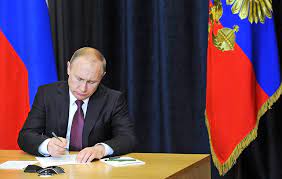Russia: Containment or Competitive Coexistence?
The article describes two strategic approaches to managing the Russia-Ukraine conflict: containment and competitive coexistence. Containment views Russia as an implacable adversary and seeks to thwart its expansionist ambitions. Competitive coexistence, on the other hand, proposes managing competition with Russia through diplomatic means, emphasizing Ukraine’s sovereignty and territorial integrity.
A containment strategy for Russia may be morally satisfying, but it fails to acknowledge the end of US supremacy.
By Thomas Graham
President Donald Trump’s proposed meeting with Russian president Vladimir Putin in Budapest may never take place, and a final settlement of the Russia-Ukraine war may lie far in the future. Yet, it is not premature to consider how such a settlement should be framed to advance US interests in European security and in relations with Russia. Broadly speaking, two strategic approaches are available: containment, the preferred option of much of the foreign-policy establishment, and competitive coexistence. The choice between them depends on how the United States assesses Russia.
As during the Cold War, containment treats Russia as an implacable adversary with intolerable geopolitical ambitions in Europe and beyond. Echoing George Kennan’s logic, it assumes that thwarting Russian expansionist ambitions will eventually erode the foundations of the regime and yield a new Russia, a country more in tune with Western values and a potential partner for the United States.
A strategy of competitive coexistence, by contrast, begins from the assumption that Russia is a permanent rival whose domestic system and strategic mindset the West cannot change through pressure or inducement. It sees the task of US foreign policy not as defeating or transforming Russia but rather as managing competition responsibly to prevent direct military confrontation, which could prove catastrophic for both sides.
Containment and competitive coexistence share the goal of preserving Ukraine’s sovereignty and preventing further Russian aggression against its neighbors. Where they diverge is in their understanding of how to address the two central issues of this conflict: security guarantees for Ukraine and the disposition of disputed territory.
Containment: Moral Clarity and Strategic Rigidity
Applied to the current war, containment would take a principled stand in support of Ukraine’s right to seek NATO membership, even if that prospect remains remote for the time being. It would place no limits on Ukraine’s security cooperation with NATO or individual allies. It would reject any restrictions on Kyiv’s military capabilities beyond its voluntary commitment not to acquire nuclear weapons. Any Russian objections would be dismissed out of hand.
Containment would also insist on Ukraine’s territorial integrity within its internationally recognized 1991 borders, refusing to accept any political settlement that legitimized Russian gains since 2014. De facto Russian control of occupied territories might be tolerated as a temporary reality. Still, the United States would support Ukraine diplomatically, politically, and economically in efforts to recover them over time.
Containment thus satisfies the moral and legal imperatives of defending sovereignty and resisting aggression. Yet it carries costs. By denying Russia any face-saving exit or security assurances, containment risks prolonging the war. It could entrench a new Cold War dynamic, destabilize Europe, and impose devastating long-term costs on Ukraine, the very nation it seeks to protect.
A strategy of competitive coexistence, by contrast, would urge Ukraine to adopt a posture of armed neutrality as a way to secure its sovereignty while addressing Russia’s security concerns. Kyiv would forswear NATO membership and agree not to host foreign forces, while still developing its defense-industrial base—with Western investment and technology—to build the weapons needed for self-defense. It would limit Ukraine’s military capabilities, but only as part of a reciprocal arrangement imposing comparable restrictions on Russian forces within a defined zone along Ukraine’s border with Russia and Belarus.
On territorial questions, competitive coexistence would accept de facto Russian control over seized Ukrainian territory without recognizing it de jure. Rather than pursuing the restoration of the 1991 borders, it would instead favor a resolution grounded in the principle of local self-determination, allowing populations in disputed areas to decide their political affiliation through an agreed, internationally supervised democratic process. The outcome would not legitimize conquest but would instead reinforce a fundamental political right.
This strategy is pragmatic rather than principled. It recognizes that Ukraine’s security ultimately depends not on Western moral commitment but on a stable balance of power. It would enable Ukraine to survive, rebuild, and integrate with Europe without becoming a permanent flashpoint for confrontation between nuclear powers.
Pragmatism for a Multipolar World
Containment remains appealing because it expresses moral conviction and the confidence of a superpower that stands astride the global stage, as the United States did in the immediate post-Cold War years. But the world in which the United States could dictate outcomes has long since passed. A policy of competitive coexistence offers a more realistic framework for managing enduring competition with Russia in a multipolar system; the United States cannot dominate, as it faces a rival it cannot vanquish.
Competitive coexistence does not appease aggressors, as its critics claim, nor does it reward aggression. It contains it through balance, restraint, and diplomacy. It sees compromise—even with unsavory rivals—as an element of statecraft in an open-ended contest in which setbacks can be redressed and advantages accumulated over time. It seeks not decisive victory but durable stability, a peace of imperfect justice but one achievable in practice.
In the end, the United States must choose between a policy of moral clarity and one that works. Competitive coexistence, for all its ambiguities and imperfections, offers the surer path to a Europe at peace and a global order that advances US interests and values, if not as fully or as rapidly as some would hope.
Thomas Graham is a distinguished fellow at the Council on Foreign Relations and the author of Getting Russia Right.
© Copyright 2025 Center for the National Interest


Коментар